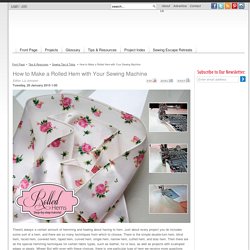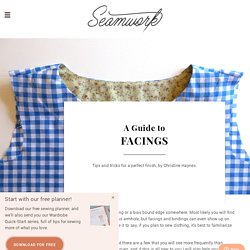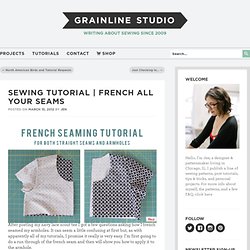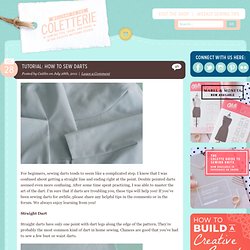

Understitching: The Secret to Perfectly Sewn Necklines! Collarless necklines come in many forms.

Some come up close to the neck, like a jewel or round neckline, while others are more revealing, like a V-neck or bateau-style neckline. But no matter the shape, these garment necklines all share one thing in common: In order for them to look just right, the facings that finish them must turn ever so slightly below the neckline edge. As a sewing instructor, I amazed at how many of my students have never heard of understitching. How to Make a Rolled Hem with Your Sewing Machine. There's always a certain amount of hemming and hawing about having to hem.

Just about every project you do includes some sort of a hem, and there are so many techniques from which to choose. There is the simple double-turn hem, blind hem, faced hem, covered hem, taped hem, curved hem, single hem, narrow hem, cuffed hem, and bias hem. Then there are all the special hemming techniques for certain fabric types, such as leather, fur or lace, as well as projects with scalloped edges or pleats. Whew! But with even with these choices, there is one particular type of hem we receive more questions about than any of the others: the rolled hem. Understitching, edgestitching, and topstitching Katie Whittle Katie teaches new skills through in-depth tutorials, sewalongs, and articles for Seamwork Magazine and The Colette Blog.

She's all about encouraging sewers to try new techniques and create a personalized wardrobe that makes them feel great! All posts by Katie More about our writers New sewists are often thrown tons of cryptic terminology when they begin sewing; at some point it sort of all sounds the same! First and foremost, say hello to your new best friend—the edgestitch foot. How to Sew Professional Sleeve Plackets. 4 {BEST} ways to make a FACING pattern and sew it. - Sew Guide. Nerdy sewing tips: Understitching – By Hand London. Alina Sewing + Design Co. Understitching is stitching the lining or facing to its seam allowance.

It is done on pocket openings, necklines, and armholes to force the facing or lining to roll cleanly to the inside and stay there. It is not visible from the outside of a garment. It can get confusing the first time you understitch because it can be difficult to orient all of the terms and instructions with the actual pieces of fabric in your hands. Seamwork Magazine. Step | 01 I prefer to use a ruler with a 45-degree line on it to cut my strips.

Line up that 45-degree line on the ruler with the selvage of your fabric, and simply cut strips in the required width using a rotary cutter. If you cannot get the length you need in one strip, not to worry, we can join them to make continuous bias tape. Step | 02 Once you have strips cut out, use the ruler and rotary cutter to trim the ends to a perfect 90-degree angle, like on the bottom strip in the image.
Step | 03 Place two of the strips on top of each other, with right sides facing. Step | 04. Sewing 101: pintuck pleats - see kate sew. Pintuck pleats are tiny decorative pleats I think they look super cute on blouses and bags.

You can put them anywhere! Pintuck pleats get their name because they are about the width of a pin. To make a pintuck pleat, fold your fabric and pin it in place. You can run the pins either parallel or perpendicular to the edge, but I find that perpendicular makes it easier to sew. (But if you want a true pintuck pleat, the width of a pin, putting them in parallel will help you gauge the size.)
I like my pintucks to be tiny so I align the needle to the far right and put my fabric on the inside of the metal presser foot edge, under the plastic. Next, run your sewing machine down your pinned edge. Pintucks – the Old Fashioned Way – Historical Sewing. Video: How to Sew and Press Tucks. 101 Sewing Tutorials for Summer!
Sewing tutorials. Construction Techniques. Construction Techniques. French All Your Seams. After posting my navy lace scout tee I got a few questions asking how I french seamed my armholes.

It can seem a little confusing at first but, as with apparently all of my tutorials, I promise it really is very easy. I’m first going to do a run through of the french seam and then will show you how to apply it to the armhole. Just a few notes before we begin… 1. french seams are usually best used on light to medium weight fabric. 2. French seams require you to split your seam allowance in two parts. This tutorial is done using a 1/2″ seam allowance, but if you are working with a 5/8″ seam allowance, sew the first seam at 3/8″ and the second at 1/4″. Part 1 | French Seams on Straight Seams Step 1 | Cut your pieces from your fabric. How to sew darts For beginners, sewing darts tends to seem like a complicated step.

I know that I was confused about getting a straight line and ending right at the point. Double pointed darts seemed even more confusing. After some time spent practicing, I was able to master the art of the dart. I’m sure that if darts are troubling you, these tips will help you! If you’ve been sewing darts for awhile, please share any helpful tips in the comments or in the forum. Straight Dart. Sewing Tips for Sewing Darts. Understanding Lining Fabric + Resources.
This is a follow-up post to this post and again, if you don’t have Easy Guide to Sewing Linings by Connie Long, you need it and you should buy the e-book right now! Today, I wanted to share my online resources plus a few tips on what kinds of fabrics can work as a lining. Sometimes ideas from others make a big difference in how we view the usefulness of a fabric. So here goes. bemberg rayon lining First let’s talk lining fabrics and what kinds of fabrics work as linings that aren’t labeled “linings.” CT-MMB.004 Inserting Jacket Linings - CT-MMB-004.pdf. Sleevehead. Sewing Taffeta Tips: Learn The Craft of Sewing on Craftsy. Taffeta is a luxurious fabric.

Lightweight but crisp, it has a slight sheen to it and is the perfect choice for formal wear. It’s also used in home decor projects. How to Test the Stretch of a Knit fabric & Sizing down the Master Pattern. The Olya Shirt by Paper Theory Designs - Sew Tessuti Blog. In my last shirt post I mentioned that I’d already chosen my next shirt project and so here it is – the Olya Shirt from Paper Theory Patterns.

I’d spied a few beautiful versions of this pattern on insta but this perfect, crisp white linen Olya from Bella took me well and truly over the ‘add to cart’ line. Let me start by saying that this pattern is such a fantastic design. The style is classic and relaxed but some very clever drafting lifts it well beyond ordinary shirt territory. A seam line runs across the shirt front, along the tops of the pockets and right down the sleeve to finish at the cuffs, so the front yoke and sleeves are made up from the same pattern piece (read: no setting in sleeves!). As is my shirt-making norm and through no fault of the pattern, I had a few stumbles with the collar and collar stand but it was nothing some time and un-picking couldn’t eventually fix.